Delivering an exceptional customer experience isn’t just a buzzword. It’s the secret sauce for building long-lasting relationships, fostering customer loyalty, and driving business growth. Customers today expect more than just good service; they want to feel valued and understood throughout their entire journey with your business.
So, how do you meet—and exceed—those expectations? This guide will walk you through proven customer experience strategies designed to delight your audience. We’ll dive into everything from creating an effective customer journey map to leveraging customer feedback and consumer research. You’ll also learn how to empower your customer support team and use technology to boost satisfaction.
By the end, you’ll have a customer experience strategy ready to elevate your business outcomes and create a seamless experience for your entire customer base. Whether you’re a SaaS company, SME, or e-commerce business, these tips will help you improve customer satisfaction scores and build stronger customer relationships.
Let’s get started with actionable insights to transform your customer experience from ordinary to extraordinary!
Understanding Customer Delight
A satisfied customer is good, but a delighted customer is priceless. The difference lies in the ability to exceed customer expectations and create moments of surprise and delight throughout the entire customer journey. Let’s explore what makes customer delight unique and how it fits into a larger customer experience CX strategy.
What is Customer Delight?
Customer delight is the emotional connection a customer feels when their experience surpasses expectations. It goes beyond resolving customer inquiries or offering excellent customer service. It’s about crafting memorable moments that resonate and foster loyal customers.
For example, imagine a customer service team that not only answers a question quickly but also anticipates future needs by offering proactive solutions. This level of care can make all the difference in creating a positive customer experience.
Why Customer Delight Matters
- Enhances Customer Loyalty: Delighted customers are more likely to become repeat buyers and brand advocates.
- Boosts Customer Lifetime Value: When customers are consistently impressed, their spending and engagement increase over their customer lifetime.
- Reduces Churn: A seamless experience combined with a genuine focus on meeting customer needs can prevent the loss of customers due to just one negative experience.
Delight vs. Satisfaction
While customer satisfaction measures whether expectations are met, delight focuses on exceeding them. For example:
- Satisfaction: Delivering a product on time.
- Delight: Delivering the product early with a personalized thank-you note.
By striving for delight, businesses create emotional connections that go beyond transactional interactions, setting the stage for lasting customer relationships.
Personalizing Customer Interactions
Personalization is at the heart of a successful customer experience strategy. Tailoring your approach to individual customer preferences not only improves customer satisfaction but also strengthens emotional connections, creating a more engaged and loyal customer base.
Why Personalization Matters
Personalized interactions make customers feel seen and valued. Studies show that businesses adopting personalization in their CX strategy often see improved net promoter scores, higher customer satisfaction scores, and stronger brand loyalty. This approach transforms one-size-fits-all interactions into meaningful experiences tailored to each customer’s journey.
How to Personalize Effectively
- Leverage Customer Data:
Use insights from market research, user feedback, and customer journey maps to understand individual needs. Tools like CRM systems can help segment your audience based on preferences and behavior.Example: If a customer persona shows a preference for email communication, ensure your follow-ups are aligned with this preference. - Create a Customer-Centric Culture:
Train your customer service team to empathize with customers and adapt their approach. By encouraging team members to put themselves in the customer’s shoes, you ensure interactions are both personal and impactful. - Use Technology for Personalization:
Employ AI tools to deliver personalized recommendations. For example, SaaS companies can suggest features based on how customers use their products, while e-commerce businesses can highlight items similar to past purchases.
Real-World Examples
- A streaming service recommending shows based on viewing habits creates a seamless and engaging experience.
- A retailer sending birthday discounts to customers adds a personal touch that strengthens customer relationships.
By personalizing the entire customer experience, you can turn interactions into memorable moments that elevate your brand and create loyal customers.
Also Read: How can you solve customer queries using the Chatbot Platform in 2024?
Leveraging Technology for Enhanced Customer Experience
Technology plays a crucial role in delivering a seamless experience that meets and exceeds customer expectations. From automating routine tasks to gathering insights through customer data, tech-driven solutions empower businesses to optimize the entire customer journey.
Key Technologies for Customer Experience Management
- Customer Relationship Management (CRM) Systems
A CRM system is the backbone of any customer-centric culture. It helps track customer interactions, preferences, and pain points across various channels. With the right CRM, your customer support team can resolve issues quickly and provide personalized service.Example: A CRM identifies repeat customers who frequently call support. The support team can proactively address recurring concerns, improving the overall customer experience CX. - AI and Automation Tools
AI-driven chatbots and automation tools streamline processes like handling customer inquiries, managing routine tasks, and even analyzing user feedback. This frees up your team to focus on more complex challenges.Example: An AI bot can respond to common questions, reducing the customer effort score and enhancing satisfaction by providing instant support. - Customer Journey Analytics
Tracking and visualizing the customer journey map outlines areas for improvement. Advanced analytics tools can identify where customers drop off, helping you address those pain points effectively.Example: A SaaS company notices low engagement during onboarding. By automating tutorial videos, they reduce friction and ensure a quality customer experience. - Feedback Collection Tools
Use platforms like surveys, live chat, and focus groups to collect feedback efficiently. Tools that integrate with CRMs ensure insights are acted upon without delay.
Benefits of Using Technology
- Reduces operational costs, especially for SMEs and e-commerce businesses.
- Improves consistency in delivering a positive customer experience across touchpoints.
- Strengthens customer loyalty by providing quicker and more personalized service.
Challenges to Address
While technology is powerful, over-reliance can lead to a loss of human touch. To strike the right balance, combine tech solutions with a trained and empathetic customer service team.
Active Listening and Feedback Implementation
Actively listening to customers and acting on their user feedback is a game-changer for building trust and improving the overall customer experience. A well-structured feedback process ensures that you understand and address customer needs, reducing friction and boosting loyalty.
Why Feedback Matters
Feedback offers direct insights into customer pain points, preferences, and expectations. It allows businesses to refine their processes, create better products, and deliver a successful customer experience strategy. Ignoring feedback, on the other hand, can result in dissatisfaction and churn.
How to Collect Customer Feedback
- Surveys and Polls:
Use tools to gather quantitative and qualitative data about the entire customer journey. Surveys can be sent via email or embedded in apps, while polls work well on social media.
Example: Ask customers to rate their experience on a scale of 1-10 to calculate a net promoter score (NPS) or customer satisfaction score (CSAT). - Focus Groups:
Engage small groups of your target audience in discussions about your service. Focus groups help uncover deeper insights than standard surveys. - Customer Support Interactions:
Train your customer support team to gather valuable feedback during interactions. They can identify recurring issues and share these insights with management for resolution. - Social Listening:
Monitor online mentions of your brand on social media and review platforms. This helps you capture unfiltered opinions and gauge the sentiment of your customer base.
Acting on Feedback
- Prioritize and Implement:
Identify recurring themes and rank them based on impact. For example, if feedback highlights long response times, improve internal processes to speed up resolutions. - Close the Loop:
Inform customers when their feedback leads to change. This reinforces trust and shows that their opinions matter.
Example: “Thanks to your suggestions, we’ve improved our product’s onboarding process for a smoother start!” - Evaluate Performance:
Regularly assess the effectiveness of implemented changes using metrics like CSAT and NPS. This ensures that updates positively influence the entire customer experience.
Benefits of Active Listening
- Builds an emotional connection by showing customers they are heard.
- Identifies and resolves issues before they escalate into larger problems.
- Helps refine a customer experience management strategy that aligns with real customer needs.
By treating feedback as a key element in your CX strategy, you not only meet but exceed customer expectations, fostering loyalty and trust.
Training Teams for Exceptional Service
A well-trained customer support team is essential for delivering a quality customer experience. They’re the frontline of your business and play a crucial role in meeting—and exceeding—customer expectations. Proper training equips teams with the skills and knowledge needed to create seamless, personalized interactions.
Key Skills for Customer Service Teams
- Active Listening:
Understanding the customer’s concerns, even beyond their words, is critical. Encourage agents to listen carefully and confirm understanding before providing solutions. - Empathy and Emotional Intelligence:
Empathy helps agents put themselves in the customer’s shoes. This creates an emotional connection and improves satisfaction. - Product Knowledge:
Teams must thoroughly understand your offerings to address customer inquiries accurately and confidently. - Problem-Solving:
A proactive approach to identifying and addressing pain points ensures quicker resolutions and enhances the overall customer experience. - Adaptability:
Customers come from diverse backgrounds, each with unique needs. Train your team to adapt their communication style to match different customer personas.
Effective Training Practices
- Role-Playing Scenarios:
Simulate real-life situations where agents handle challenging customers, technical issues, or sensitive complaints. This helps build confidence and improves problem-solving skills. - Regular Workshops and Updates:
Conduct training sessions on industry trends, new tools, and evolving customer behaviors. Staying updated ensures that teams can deliver a successful customer experience strategy. - Performance Feedback:
Provide constructive feedback based on real interactions. Use tools to analyze metrics like response time and customer satisfaction scores to identify improvement areas. - Cross-Department Collaboration:
Encourage collaboration with other teams, such as marketing or product development, to ensure the entire organization is aligned with your customer experience CX strategy.
Empowering Your Team
- Equip agents with tools that streamline workflows, such as AI chatbots or CRM platforms.
- Foster a customer-centric culture where teams feel motivated to go the extra mile.
- Recognize and reward excellent performance to boost morale and maintain consistency in service.
Impact of Well-Trained Teams
A skilled and motivated team creates loyal customers, increases customer lifetime value, and improves key metrics like net promoter score. They become ambassadors for your brand, delivering experiences that strengthen customer relationships.
Case Studies of Successful Customer Delight
Learning from real-world examples is a powerful way to understand how businesses have implemented effective customer experience strategies to exceed expectations. Here are some companies that have mastered the art of delighting customers.
1. Zappos: Building Customer Loyalty Through Service

Zappos, an e-commerce giant, is known for its exceptional customer service team. Their philosophy revolves around creating emotional connections and providing excellent customer service.
Strategy:
- Empowered employees to go above and beyond, including extended calls to solve complex customer inquiries.
- Offered free returns and personalized communication to reduce customer effort score.
Impact:
Zappos built a reputation for trust and reliability, boosting customer satisfaction scores and fostering a loyal customer base.
2. Spotify: Personalizing the Customer Journey
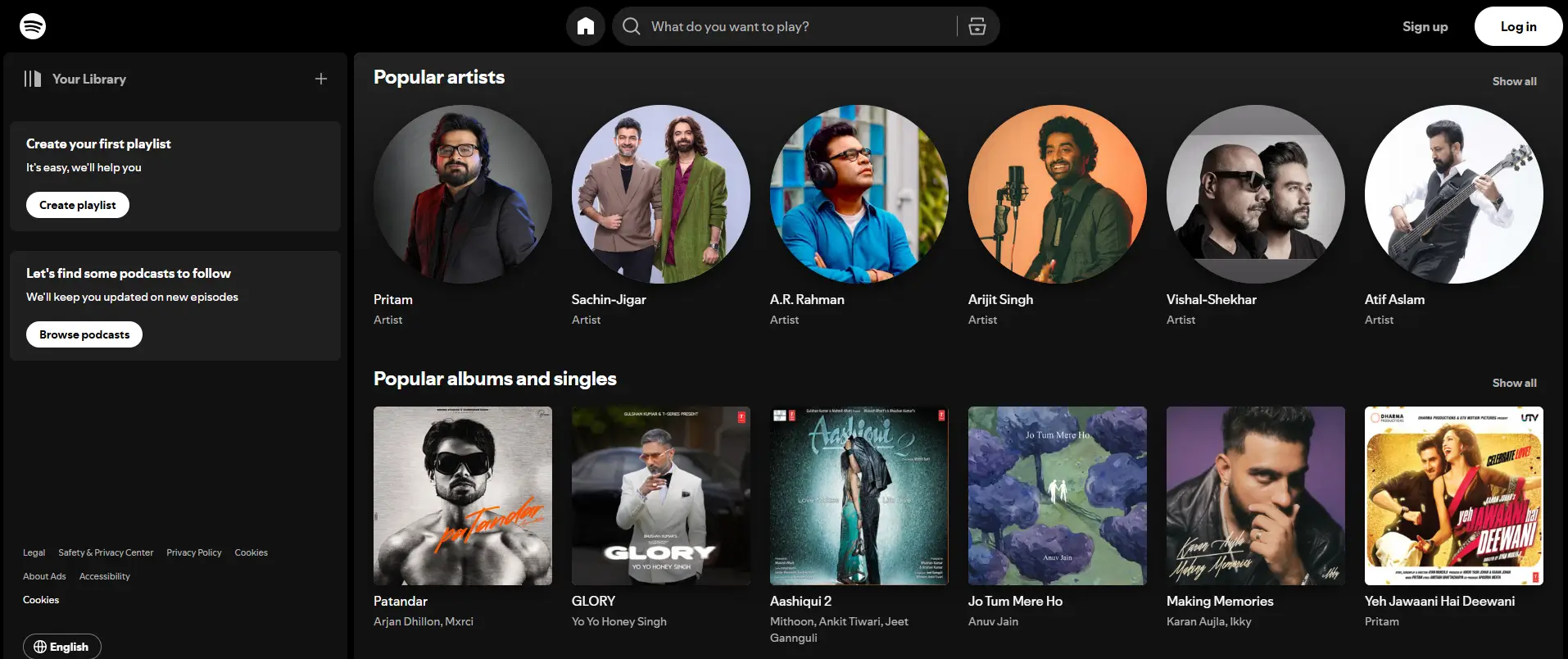
Spotify leverages data to craft a personalized customer experience for every user, making it a leader in customer-centric culture.
Strategy:
- Created the “Wrapped” campaign, which shows users their listening habits over the year, a powerful example of how to use customer data.
- Offered personalized playlists tailored to individual customer preferences and moods.
Impact:
Spotify’s approach strengthened its emotional connection with users, increasing retention and customer lifetime value.
3. Ritz-Carlton: Anticipating Customer Needs
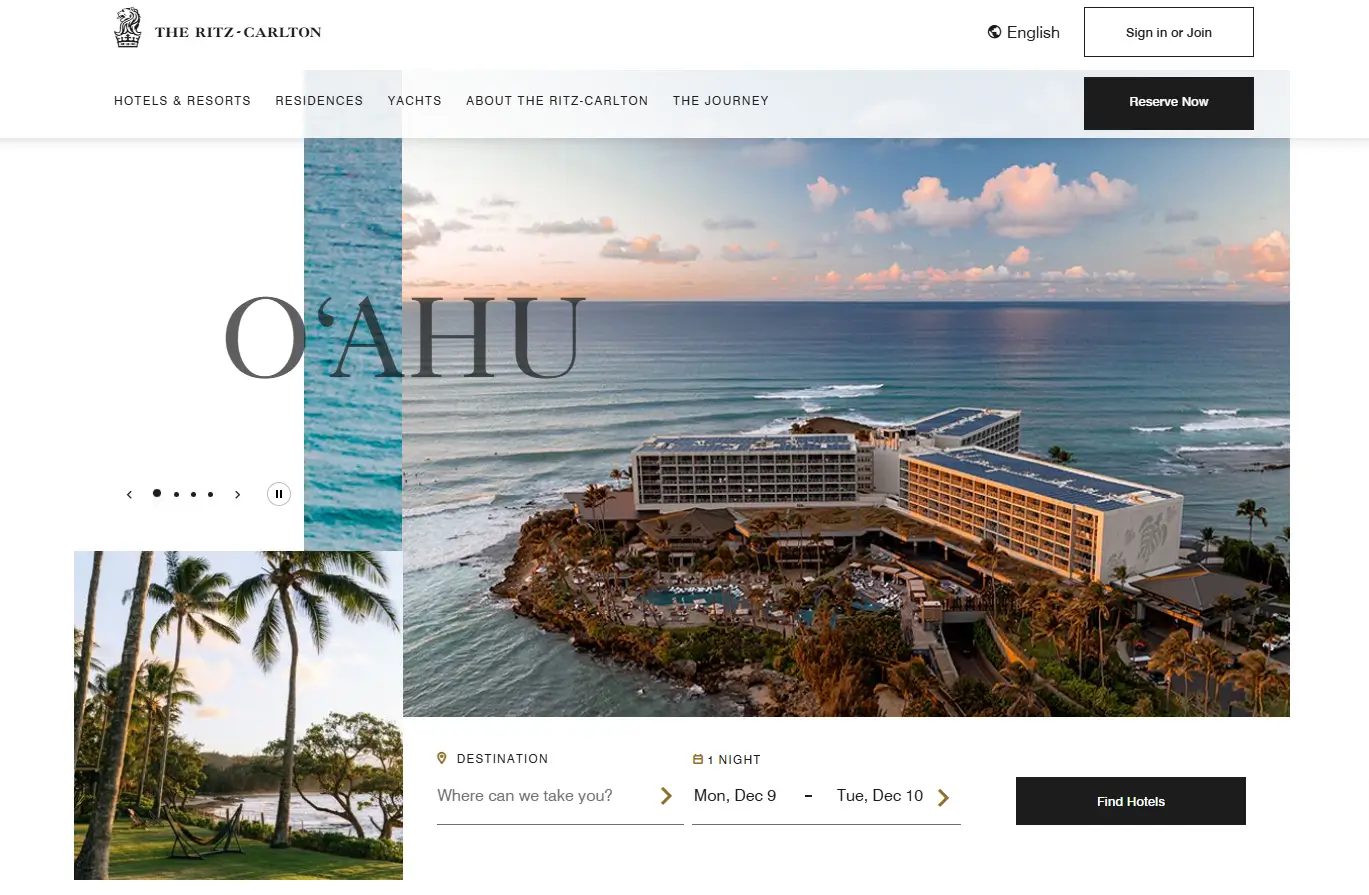
Ritz-Carlton sets the bar for luxury customer experience CX by training staff to proactively address pain points.
Strategy:
- Staff empowered to spend up to $2,000 to resolve customer complaints or create memorable experiences.
- Maintained detailed records of customer preferences to anticipate needs during future stays.
Impact:
These efforts have enhanced the entire customer experience and ensured a seamless, unforgettable journey for guests.
4. Slack: Seamless Support for SaaS Users
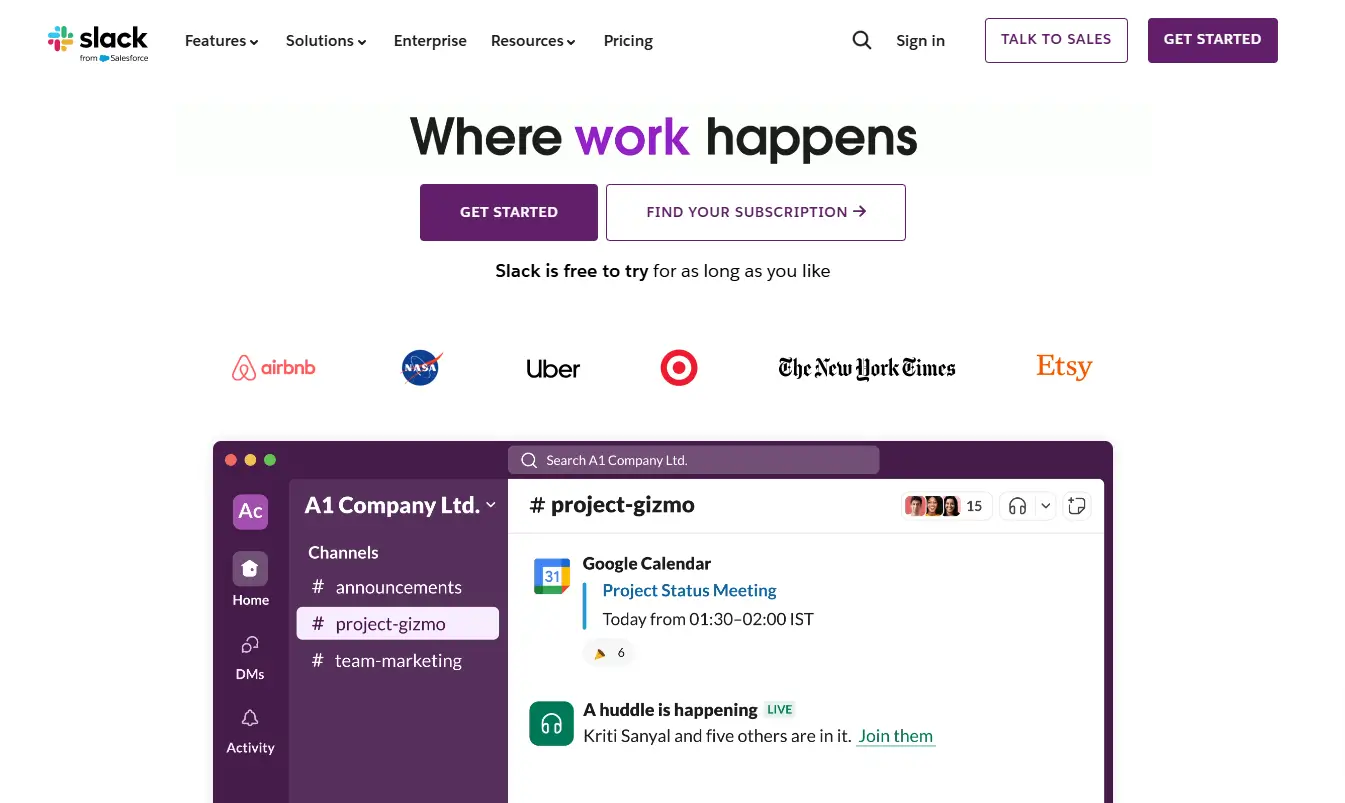
Slack’s customer success model ensures businesses can seamlessly adopt their platform.
Strategy:
- Offered extensive resources like webinars, guides, and live support.
- Proactively reached out to new users to ensure they were set up correctly, a hallmark of an effective customer experience strategy.
Impact:
Slack’s proactive and user-focused approach helped them establish a strong CX strategy, boosting satisfaction and customer retention.
5. Amazon: Redefining Convenience
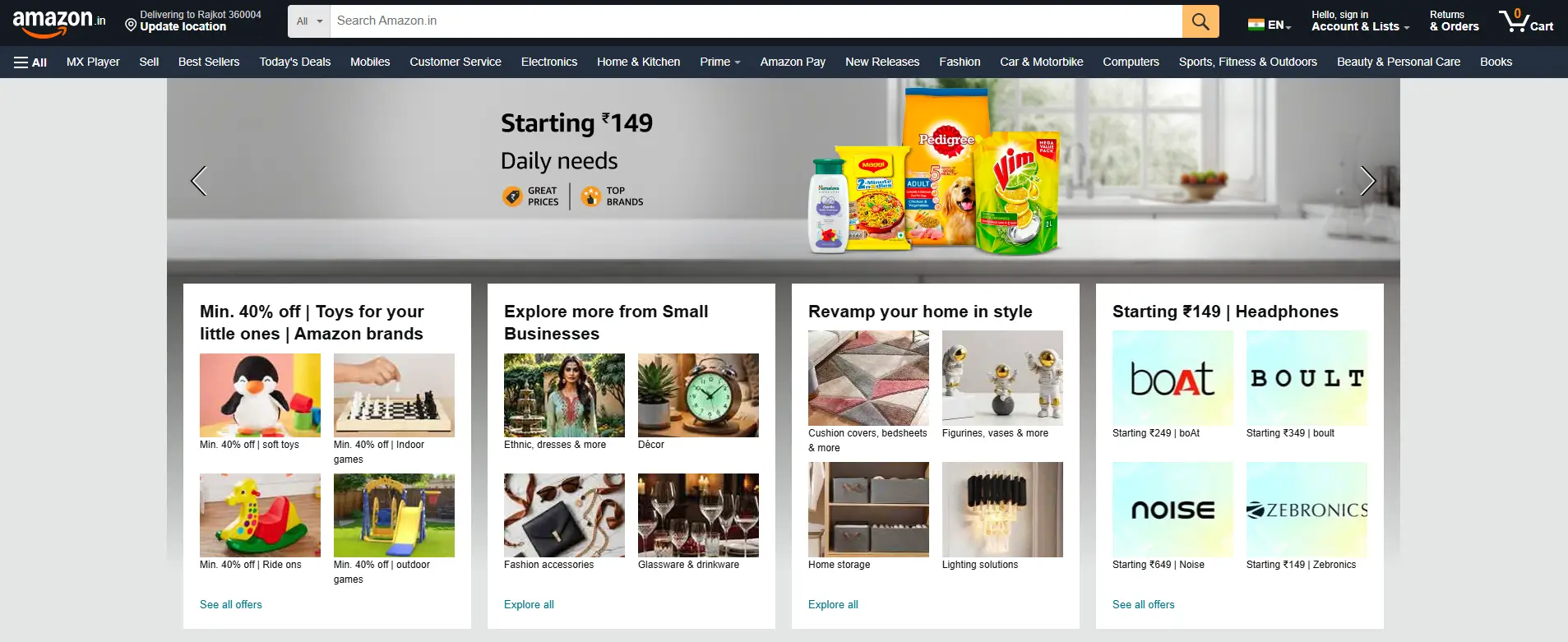
Amazon’s relentless focus on the customer journey ensures that users experience unparalleled convenience.
Strategy:
- Simplified navigation and purchase processes, reducing friction in the entire customer journey.
- Innovated with technologies like Alexa to meet evolving customer needs.
Impact:
By consistently delivering a seamless experience, Amazon has set new benchmarks for customer satisfaction and loyalty.
These examples highlight how understanding and addressing customer pain points, leveraging competitive insight, and focusing on business goals can lead to remarkable outcomes. By applying these lessons, businesses can craft their own customer experience CX strategies that delight and retain customers.
Measuring the Impact of Customer Experience
To understand whether your customer experience strategies are working, it’s essential to measure their impact. Tracking performance helps identify strengths, areas for improvement, and how well you’re meeting business goals.
Key Metrics to Evaluate Performance
Customer Satisfaction Score (CSAT)
CSAT measures how satisfied customers are with a specific interaction or experience.
How to measure:
- Ask customers to rate their experience on a scale (e.g., 1-5 or 1-10).
- Example question: “How satisfied were you with your recent interaction?”
Net Promoter Score (NPS)
NPS gauges customer loyalty by asking how likely customers are to recommend your business.
How to measure:
- Use a scale from 0-10, with follow-up questions for detractors and promoters.
- Categorize responses: 0-6 (detractors), 7-8 (passives), 9-10 (promoters).
Customer Effort Score (CES)
CES tracks how easy it is for customers to resolve issues or complete tasks.
How to measure:
- Ask: “How easy was it to resolve your issue today?”
- Lower effort scores correlate with higher satisfaction.
Customer Lifetime Value (CLV)
CLV measures the total revenue a customer generates over their customer lifetime.
Why it matters:
- Higher CLV indicates stronger customer relationships and successful retention strategies.
Churn Rate
Churn rate calculates the percentage of customers who stop using your product or service.
Why it matters:
- A low churn rate signals effective customer experience management.
Tools for Measurement
- CRM Platforms: Integrate metrics tracking to analyze trends and gather customer data.
- Feedback Platforms: Use surveys, polls, and focus groups to collect feedback.
- Analytics Tools: Leverage software that visualizes the entire customer journey map to identify drop-off points and improve retention.
Evaluating Business Outcomes
Tie these metrics back to tangible business outcomes, such as revenue growth, customer acquisition costs, or improved operational efficiency. This ensures your CX strategy aligns with your overarching objectives.
Iterate and Improve
Measurement is not a one-time activity. Regularly revisit and refine your customer experience CX strategy to adapt to evolving customer needs and industry trends.
Avoiding Common Pitfalls in Customer Experience
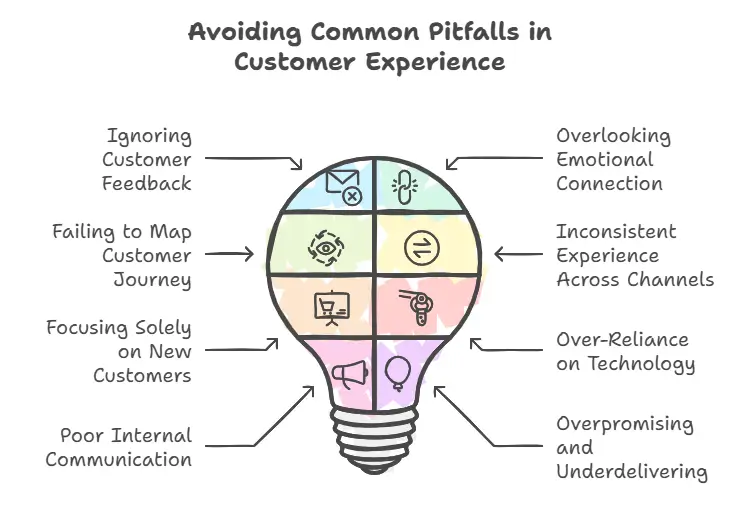
Even the most robust customer experience strategies can fall short if certain challenges aren’t addressed. Avoiding these common pitfalls ensures a smooth customer journey and reinforces loyalty across your customer base.
1. Ignoring Customer Feedback
Failing to act on user feedback or insights gathered from surveys and focus groups can erode trust. Customers expect businesses to address their concerns.
Solution:
- Establish a process to collect and prioritize feedback.
- Close the loop by informing customers about actions taken to resolve issues.
2. Overlooking the Emotional Connection
A focus solely on operational efficiency can strip away the personal touch, weakening customer relationships.
Solution:
- Train your customer service team to show empathy and build emotional connections.
- Use personalization tools to tailor interactions and create moments that delight.
3. Failing to Map the Entire Customer Journey
Without a clear customer journey map, pain points may go unnoticed, leading to frustration during critical touchpoints.
Solution:
- Regularly update your customer journey map outlines to reflect real-world interactions.
- Leverage analytics to understand where drop-offs occur and address them proactively.
4. Inconsistent Experience Across Channels
Providing varying levels of service across different platforms can confuse and frustrate customers.
Solution:
- Align your team and processes to ensure consistency across email, phone, chat, and social media.
- Create a unified approach using technology, such as CRM tools, to centralize customer information.
5. Focusing Solely on New Customers
While acquiring new customers is important, neglecting existing ones can damage customer loyalty and reduce customer lifetime value.
Solution:
- Develop retention strategies that reward loyal customers, such as exclusive perks or personalized offers.
- Continue engaging with your customer base through targeted campaigns and ongoing support.
6. Over-Reliance on Technology
Automating too much can make experiences feel impersonal, leading to a disconnection with your target audience.
Solution:
- Balance automation with human interaction, especially for complex or emotional scenarios.
- Use tools like AI and chatbots to handle routine inquiries while keeping your team available for more nuanced needs.
7. Poor Internal Communication
When departments aren’t on the same page, customers can receive conflicting information or experience delays.
Solution:
- Foster collaboration across teams by aligning business processes with shared business goals.
- Use tools that improve communication between departments, like project management platforms or shared dashboards.
8. Overpromising and Underdelivering
Raising customer expectations only to fall short is a recipe for dissatisfaction.
Solution:
- Set realistic expectations in your marketing and communication efforts.
- Deliver consistently to maintain a quality customer experience.
Avoiding these pitfalls requires proactive effort, but the rewards—like stronger customer relationships, increased loyalty, and improved satisfaction—are well worth it.
Cost-Effective Strategies for SMEs to Enhance Customer Experience
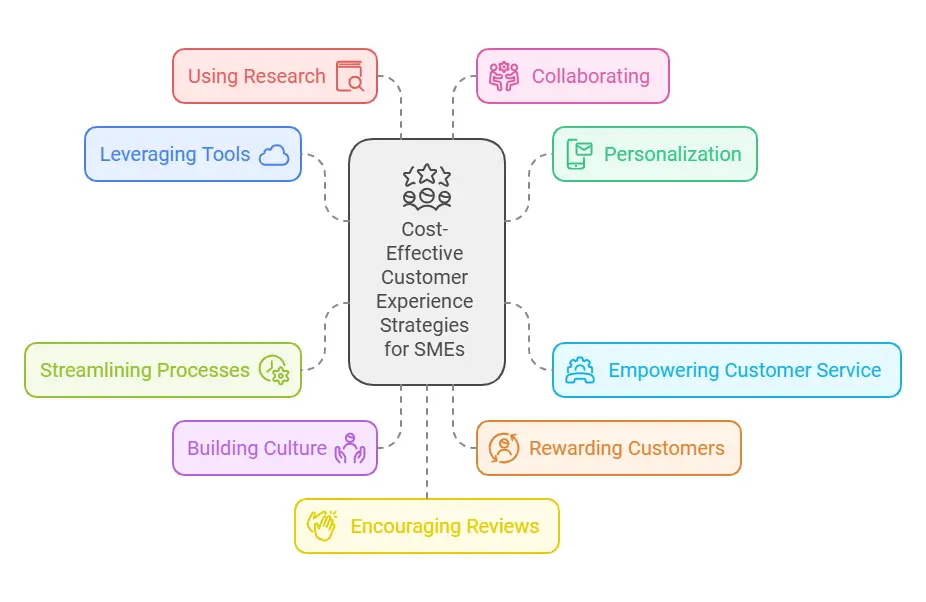
Small and medium-sized enterprises (SMEs) often face budget constraints, but that doesn’t mean they can’t deliver a standout customer experience CX. By focusing on affordable and impactful tactics, SMEs can delight customers while staying within their means.
1. Leverage Free or Low-Cost Tools
- CRM Platforms: Use cost-effective options like HubSpot or Zoho CRM to track customer interactions and manage the entire customer journey.
- Feedback Tools: Platforms like Google Forms or Typeform allow you to collect feedback without incurring high costs.
- Social Media: Build a strong online presence and engage with your customer base on platforms where they already spend time.
2. Focus on Personalization
- Use customer data to tailor offers and communications.
- Small gestures, like personalized thank-you emails or handwritten notes, can make a big impact on customer satisfaction and loyalty.
Example: An online store sending a personalized email with product recommendations based on past purchases.
3. Empower Your Customer Service Team
- Train employees to provide empathetic and solution-oriented support.
- Equip your customer support team with knowledge about your products or services, ensuring smooth resolution of customer inquiries.
Tip: Role-playing scenarios can be a cost-effective way to improve problem-solving skills.
4. Streamline Processes for a Seamless Experience
- Simplify checkout or onboarding processes to reduce the customer effort score.
- Regularly update your website or app to ensure smooth navigation.
Example: An SME optimizing its website to ensure customers can find key information or complete purchases quickly.
5. Build a Customer-Centric Culture
- Encourage all employees, regardless of their role, to prioritize customer needs.
- Celebrate success stories where employees have gone above and beyond for customers.
6. Reward Loyal Customers
- Offer loyalty programs or discounts for repeat buyers.
- Send exclusive offers or early access to new products to long-term customers.
Example: A coffee shop offering a free drink after a certain number of purchases to enhance customer lifetime value.
7. Use Consumer Research to Identify Pain Points
- Conduct surveys or hold informal focus groups to understand areas for improvement.
- Act on the findings to address customer concerns, enhancing the overall customer experience.
8. Collaborate with Local Businesses
- Partner with other SMEs to create bundled offers or cross-promotions that attract a wider target audience.
9. Encourage Customer Reviews
- Ask satisfied customers to leave positive reviews online. This builds trust and attracts new customers without a hefty marketing budget.
10. Monitor and Adapt
- Regularly review customer satisfaction scores and other key metrics to identify trends.
- Adapt strategies based on changing customer preferences or industry trends.
Even with limited resources, SMEs can create a meaningful customer experience CX by focusing on small yet impactful changes. These strategies not only improve customer satisfaction but also help build lasting customer relationships.
Conclusion
Delighting customers isn’t just about meeting expectations; it’s about consistently going above and beyond. By focusing on personalization, leveraging technology, empowering teams, and acting on customer feedback, businesses can craft a successful customer experience strategy that drives loyalty and satisfaction.
Remember, it’s the small, thoughtful touches—like understanding customer needs, reducing the customer effort score, and addressing pain points—that leave lasting impressions. Whether you’re using innovative tools or simple gestures to create connections, the goal is to provide a seamless journey for your entire customer base.
For SaaS companies, SMEs, e-commerce businesses, and customer support teams, the strategies discussed here aren’t just theoretical. They are practical, actionable, and tailored to create a meaningful impact on customer relationships. By prioritizing the customer’s perspective and continually refining your approach, you’ll ensure that your CX strategy is ready to handle evolving expectations.
Start with one improvement at a time and watch how it transforms your business outcomes and fosters loyal customers who stick around for the long haul.
FAQ Section
1. What is the most important element of a successful customer experience strategy?
The key to a successful customer experience strategy is understanding and addressing customer needs at every touchpoint of their journey. This involves a blend of personalization, seamless interactions, and proactive problem-solving. Using tools like a customer journey map and acting on user feedback can also help refine the experience.
2. How can small businesses provide excellent customer service with limited resources?
Small businesses can focus on affordable tactics such as leveraging free tools for collecting feedback, training their customer support teams, and prioritizing personalization. Small gestures like thank-you notes or loyalty rewards can make a big impact. Investing in scalable, cost-effective technologies like CRM platforms can also enhance the customer experience CX.
3. What’s the difference between customer satisfaction and customer delight?
Customer satisfaction occurs when expectations are met, while customer delight happens when those expectations are exceeded, creating a stronger emotional connection. For instance, delivering a product on time satisfies, but including a personalized note with the delivery delights.
4. How can businesses measure customer experience effectively?
Metrics like Customer Satisfaction Score (CSAT), Net Promoter Score (NPS), and Customer Effort Score (CES) are excellent starting points. These help gauge satisfaction, loyalty, and ease of interaction. Analyzing customer lifetime value (CLV) and monitoring churn rates also provide valuable insights into the success of your CX strategy.
5. How do you handle negative feedback without losing customers?
Negative feedback is an opportunity to improve. Listen actively, empathize with the customer, and address their concerns promptly. Close the loop by informing the customer about actions taken to resolve the issue. Turning a bad experience into a positive one can convert dissatisfied customers into loyal advocates.


